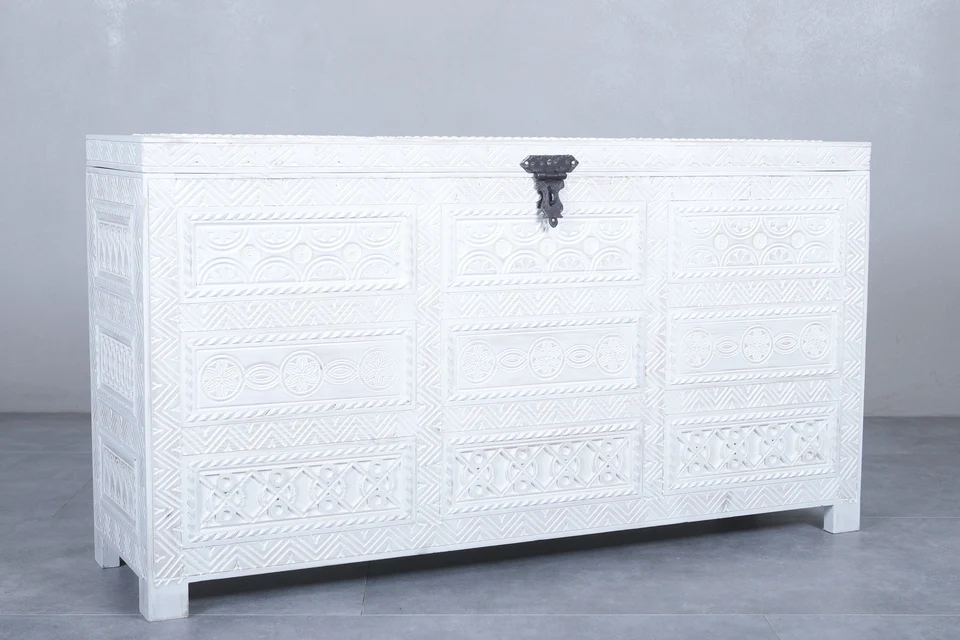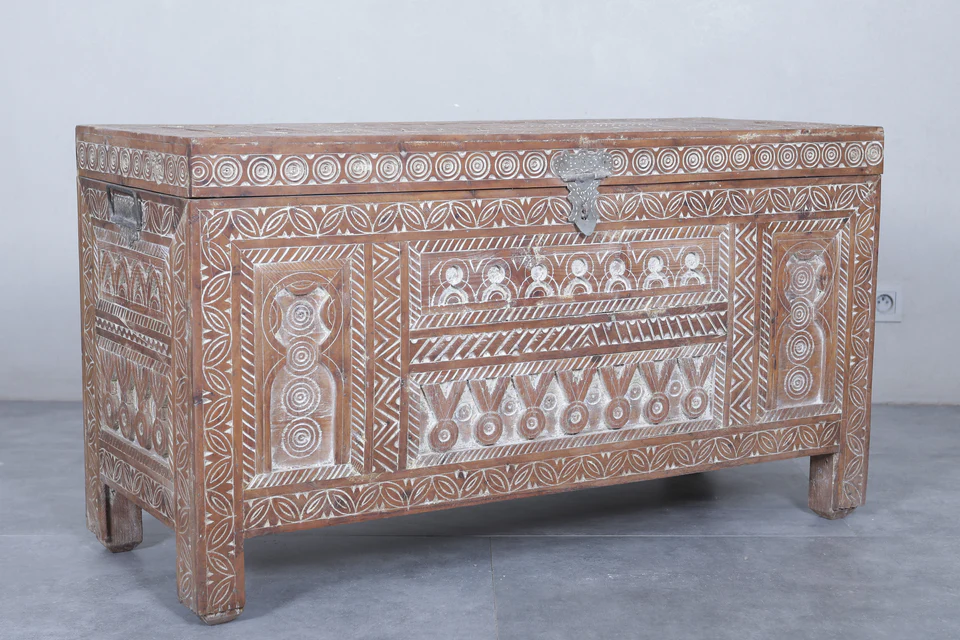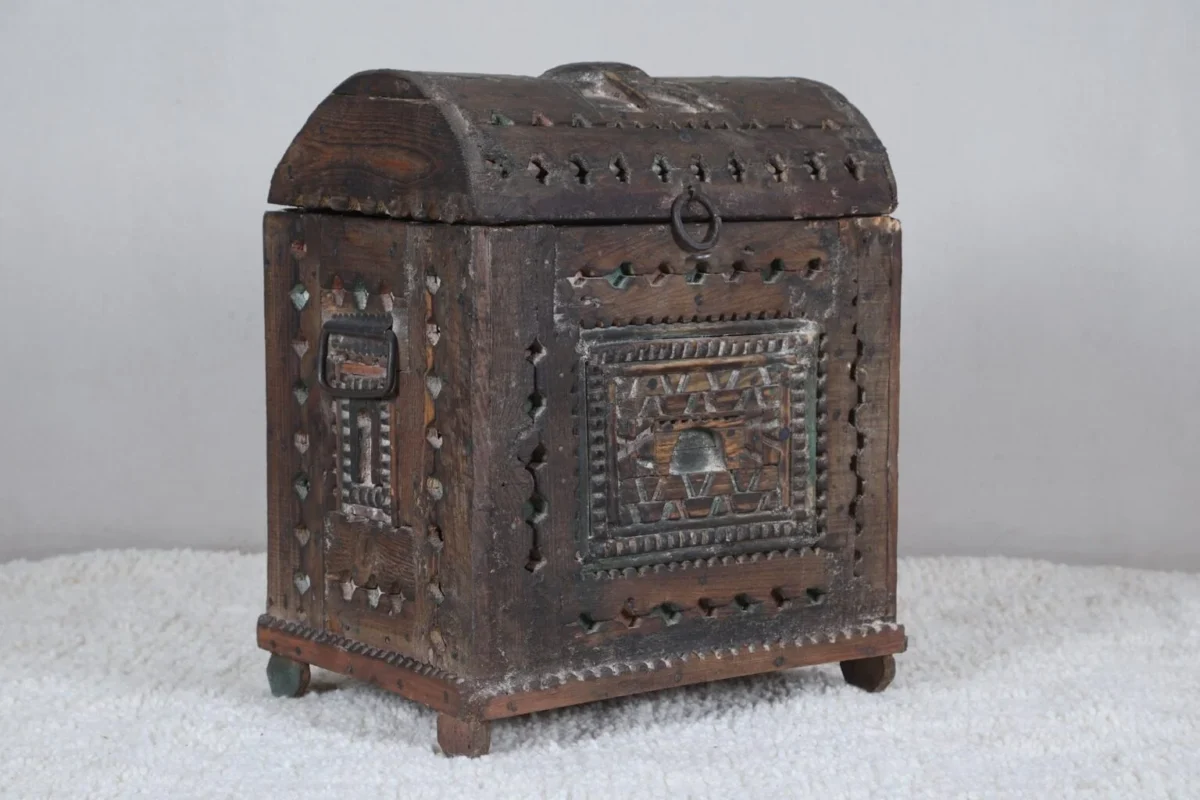Introduction to Moroccan Chests
Moroccan chests have long held a significant place in both the history and culture of Moroccan decor. These distinctive pieces are more than just functional storage solutions; they are works of art that tell stories of Morocco’s rich heritage. Crafted with intricate detailing, these chests have been an integral part of Moroccan homes for centuries, serving not only as a practical asset but also as a symbol of wealth and craftsmanship.
The usage of Moroccan chests spans generations, with each piece often being passed down as a cherished family heirloom. Traditionally, they were used to store valuable items such as textiles, jewelry, and important documents. Over time, their beauty and utility have transcended the borders of Morocco, captivating the hearts of global home decor enthusiasts.
As Moroccan decor has gained international acclaim, so too have Moroccan chests found their place in homes around the world. These chests are celebrated for their unique and elaborate design elements which often feature geometric patterns, vibrant colors, and intricate carvings. Each element of design not only enhances the aesthetic appeal of the chests but also holds cultural significance, often reflecting the traditional art forms and motifs native to different regions within Morocco.
Today, Moroccan chests continue to be a sought-after element in interior design, blending seamlessly into various decor styles ranging from bohemian to contemporary. They serve as a focal point in living rooms, bedrooms, and entryways, offering both storage and style. Their global appeal is a testament to their timeless design and the enduring allure of Moroccan craftsmanship.
As we delve deeper into the design elements and practical uses of Moroccan chests, it becomes apparent why these exquisite pieces are much more than mere storage solutions—they are storytellers that bring a touch of Moroccan elegance into any home.
Historical Background
Moroccan chests, known for their intricate designs and rich heritage, have a storied history that spans several centuries. These chests are a testament to the region’s rich cultural tapestry, reflecting the diverse influences that have shaped Moroccan art and craftsmanship. The origins of Moroccan chests can be traced back to ancient times, with their evolution being deeply intertwined with the history of the Berber, Arab, and Andalusian cultures.
The Berber communities, the indigenous people of North Africa, laid the foundation for the distinctive styles found in Moroccan chests. Berber artisans adhere to traditional woodworking techniques that have been passed down through generations. Utilizing locally-sourced materials, they craft chests that are not only functional but also rich in symbolic meanings, with geometric patterns and talismanic designs that convey protection and prosperity.
With the Arab conquest of North Africa in the 7th century, new artistic influences began to merge with the indigenous Berber traditions. The infusion of Arab artistry introduced intricate calligraphy, floral motifs, and the use of elaborate inlays with materials such as bone, ivory, and metal. This blend significantly enriched the design vocabulary of Moroccan chests, creating pieces that are both visually stunning and culturally significant.
During the 8th to the 15th centuries, the Andalusian influence further expanded the artistic horizons of Moroccan chests. The migration of artisans from Al-Andalus to Morocco brought sophisticated craftsmanship techniques and luxurious materials, resulting in chests adorned with detailed Moorish arches, arabesque patterns, and lush ornamentation. This period marked a high point in the fusion of styles, culminating in chests that are masterpieces of decorative art.
The historical journey of wooden chests is a vivid portrayal of cultural amalgamation, where traditional techniques and diverse influences converge to create exquisite pieces. These chests not only serve as functional storage solutions but also as cultural artifacts that capture the essence of Morocco’s rich and layered history.
Materials and Construction Techniques
Moroccan chests stand out due to their use of diverse and high-quality materials. Primarily, these impressive pieces are constructed using robust wood varieties, such as cedar and walnut. The wood’s durability ensures the longevity of each chest, making them cherished family heirlooms. Additionally, the use of metals, including brass and silver, plays a significant role in enhancing the aesthetic appeal. Metal accents often appear as intricate inlays or decorative overlays, contributing to the chest’s overall allure.
Moreover, bone and mother-of-pearl are commonly employed for inlay work, creating stunning patterns and visual interest. This intricate process involves embedding finely shaped pieces into the wooden surface, a technique demanding precision and time. Leather, too, features prominently; often adorning the exterior, it complements the other materials while adding texture and richness. Highly skilled artisans execute these meticulous processes, their expertise and dedication evident in every detail.
The craftsmanship behind Moroccan chests is profound, beginning with masterful woodworking. Artisans adeptly carve elaborate designs into the wood, such as floral motifs and geometric patterns, embodying traditional Moroccan aesthetics. These carvings are not only beautiful but also reflective of cultural significance and historical symbolism. Furthermore, painting techniques add vibrant color schemes, utilizing natural dyes to ensure the designs last for generations.
Creating a Moroccan chest is an exceptionally time-intensive endeavor. Each chest requires countless hours of painstaking effort, passed down through generations of artisans. The high level of skill necessary for the complex construction methods – including wood carving, metal overlaying, and intricate inlay work – underscores the chests’ value and uniqueness. These masterpieces are more than functional items; they are works of art that bring a piece of Moroccan heritage into your home.
Design Elements and Patterns
Moroccan chests are a remarkable blend of artistic expression and cultural heritage, showcasing a variety of unique design elements and patterns. One of the most defining characteristics of these chests is the extensive use of geometric shapes. Intricate patterns often feature interlocking shapes such as squares, diamonds, and triangles, forming complex and visually stimulating designs. These geometric patterns are not merely decorative; they often hold symbolic significance, representing concepts such as unity, eternity, and the interconnectedness of life.
Another prominent feature in Moroccan chest design is the arabesque. This form of artistic decoration is characterized by rhythmic linear patterns of scrolling and interlacing foliage or plain lines. Arabesques are deeply rooted in Islamic art and are renowned for their elaborate and fluid forms, which embody a sense of infinite extension. These patterns often symbolize the infinite nature of creation, a reflection of the divine.
Floral motifs are also commonly found on Moroccan chests, beautifully merging natural elements with artistic flair. These motifs can range from stylized flowers and leaves to more abstract interpretations. The inclusion of floral designs symbolizes growth, life, and nature – substantial elements within Moroccan culture. Additionally, the work of artisans incorporates these motifs to add a touch of grace and elegance to the chests.
Finally, symbolic patterns are integral to the design of Moroccan chests. Recurring symbols often found include the hand of Fatima (Hamsa), which is believed to ward off evil and bring good fortune, and the star, symbolizing guidance and protection. These symbols are not just ornamental; they carry profound cultural and spiritual meanings, reflecting the deeply rooted beliefs and traditions of Moroccan society.
The artistry behind these chests lies in their ability to tell a story through patterns and symbols, making each piece not just a functional storage item but also a work of art that brings a piece of Moroccan heritage into your home. The combination of geometric precision, fluid arabesques, delicate floral motifs, and powerful symbols results in a visually captivating and culturally rich piece of furniture.
Functional and Aesthetic Purposes
Moroccan chests are renowned for their dual-purpose utility, serving both as indispensable storage units and as striking decorative elements in the home. The artisanship and intricate details emblazoned on these chests elevate them beyond mere furniture to prized pieces that reflect Morocco’s rich cultural tapestry.
In a functional capacity, Moroccan chests are highly versatile. Their ample storage space renders them perfect for holding a variety of everyday items such as linens, clothing, and keepsakes. They can be placed at the foot of the bed in bedrooms to conveniently store blankets and beddings, or in living rooms to keep books, magazines, and remotes neatly tucked away yet within easy reach.
From an aesthetic perspective, Moroccan chests make a bold statement. Their elaborate designs, which often feature colorful inlays, carved motifs, and metal fittings, add an exotic touch to any space. They are particularly effective in entryways, serving as eye-catching focal points that set the tone for the rest of the home. Additionally, their ornate exteriors harmonize well with eclectic, bohemian, and even modern interior design styles.
For example, in a living room with a contemporary design, a Moroccan chest can introduce a layer of depth and complexity by contrasting minimalist decor with its opulent detailing. In a traditional setting, it seamlessly blends with other antique pieces, creating a cohesive and harmonious look.
The adaptability of Moroccan chests ensures that they not only meet practical storage needs but also contribute significantly to the visual and thematic coherence of different spaces within a home. Their ability to effortlessly combine function and ornamentation makes them a cherished addition to diverse interior design schemes, enhancing both utility and aesthetics.
Choosing the Right Moroccan Chest for Your Home
When selecting the perfect Moroccan chest for your home, it is essential to consider several key factors to ensure it harmonizes with your existing decor and serves your intended purposes effectively. First and foremost, assess the size of the Moroccan chest in relation to the space where it will be placed. Whether you are looking for a substantial storage solution in a larger living area or a smaller, decorative accent for a cozy bedroom corner, the dimensions should complement the room without overwhelming it.
Color scheme plays a crucial role in integrating the Moroccan chest seamlessly into your home. Traditional Moroccan chests often boast vibrant colors and intricate patterns. Consider how these hues and designs will interact with your existing color palette. If your decor is predominantly neutral, a boldly colored Moroccan chest can act as an eye-catching focal point. Alternatively, for rooms with already dynamic color schemes, selecting a chest with more subdued tones can maintain balance while still adding an exotic touch.
Design compatibility is also vital in ensuring cohesiveness within your interior space. Moroccan chests come in various styles, from elaborately carved wood to those adorned with metal accents or intricate inlays. Think about the aesthetic of your existing furniture and decor—whether it leans towards modern minimalism, rustic, or eclectic—and choose a Moroccan chest that complements rather than clashes. For instance, a chest with ornate metalwork might pair beautifully with industrial chic furnishings, while intricately carved wood could enhance a bohemian-inspired living space.
Beyond aesthetic considerations, think about the intended use of the Moroccan chest. Are you seeking additional storage for household items, or is the piece to serve more decorative purposes? For practical storage, ensure the chest offers sufficient space and functionality. For decorative use, focus more on its visual appeal and how it enhances the room’s overall ambiance.
Lastly, pairing your Moroccan chest with existing decor and furniture can elevate the room’s design. Consider accessories that echo its style, such as cushions with similar embroidery, rugs with complementary patterns, or lamps that reflect Moroccan craftsmanship. Thoughtfully integrating these elements can create a cohesive and captivating decor scheme while showcasing the rich design of your Moroccan chest.
Caring for and Maintaining Moroccan Chests
Ensuring the longevity of Moroccan chests requires attention to detail and a commitment to proper maintenance techniques. These pieces are renowned for their intricate designs and exquisite craftsmanship, which demand careful upkeep to preserve their beauty and functionality over time.
Cleaning a Moroccan chest begins with a gentle approach. Use a soft cloth to remove dust and debris regularly. For deeper cleaning, a mild soap solution can be employed. Dampen a cloth with the solution and gently wipe down the surface, taking care not to oversaturate the wood as excessive moisture can lead to warping and damage. It’s crucial to avoid harsh chemicals and abrasive cleaners which can strip the finish and harm the intricate designs.
Polishing the wood is another key aspect of maintaining Moroccan chests. Utilize a high-quality furniture polish or wax that is specifically formulated for wooden surfaces. Apply it in small amounts with a soft cloth, following the grain of the wood. This not only enhances the natural luster but also provides a protective layer against wear and tear. For metal accents and embellishments, a non-abrasive metal polish can be used to retain their sheen without damaging the surrounding materials.
Protecting Moroccan chests from damage involves strategic placement and environmental considerations. Position these pieces away from direct sunlight, as prolonged exposure can fade the vibrant colors and intricate designs. Moreover, keeping them in areas with stable humidity and temperature levels is essential to prevent warping and cracking. Using coasters or mats under decorative items can also help minimize surface scratches.
Preserving the detailed craftsmanship inherent in Moroccan chests is paramount. Regular inspections for any signs of wear or damage are advisable. Early detection of issues such as loose joints or chipped paint allows for timely repairs, maintaining the chest’s structural integrity and aesthetic appeal. Engaging a professional conservator for significant restoration ensures that the original artistry is respected and retained.
In sum, the beauty of Moroccan chests lies in their intricate designs and superb craftsmanship. By adopting meticulous cleaning, polishing, and protective strategies, these striking pieces can be cherished and admired for generations. Proper care not only maintains their aesthetic value but also honors the rich cultural heritage they represent.
Where to Find Authentic Moroccan Chests
When searching for authentic Moroccan chests, it is important to know where to look if you want to add true artisanal beauty to your home. Authentic Moroccan chests can be found through various channels, and each offers its own unique advantages.
One of the most reliable ways to procure authentic Moroccan chests is by purchasing directly from local artisans. In Morocco, cities like Marrakech and Fez boast bustling souks where skilled craftsmen produce and sell their works. These craftsmen often apply traditional techniques passed down through generations, ensuring that each chest is steeped in cultural heritage. Travel to these regions not only allows you to witness the creation process but also provides the opportunity to buy directly from the makers, supporting their craftsmanship.
Specialized furniture stores that concentrate on Moroccan decor are another excellent option. These stores, both physical and online, tend to offer carefully curated selections of Moroccan chests. They frequently collaborate with artisans in Morocco to ensure authenticity, providing a seamless shopping experience for those who may not be able to travel. Some well-known stores include Tazi Designs and Imports From Marrakesh, which have earned reputations for delivering genuine, high-quality pieces.
Online marketplaces are increasingly becoming a popular source for Moroccan chests as well. Websites such as Etsy and eBay feature listings from various sellers, including artisans based in Morocco. For those considering this route, it is vital to verify the credibility of the seller. Look for customer reviews, detailed descriptions, and verified certifications to differentiate between genuine pieces and mass-produced imitations. Online platforms like Novica, which partners directly with local artisans, can also guarantee the authenticity of their inventory.
To further ensure you’re purchasing an authentic Moroccan chest, look for key characteristics such as intricate designs, hand-carved patterns, and quality materials like cedar or mahogany. Reputable suppliers are transparent about the origins and materials of their items, allowing you to buy with confidence. Ultimately, the authenticity of a Moroccan chest adds value and charm, making it an enchanting addition to any home.




